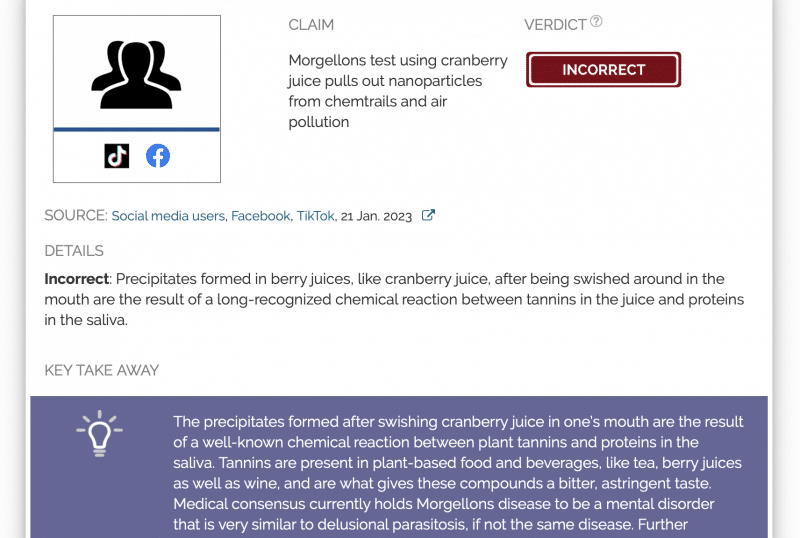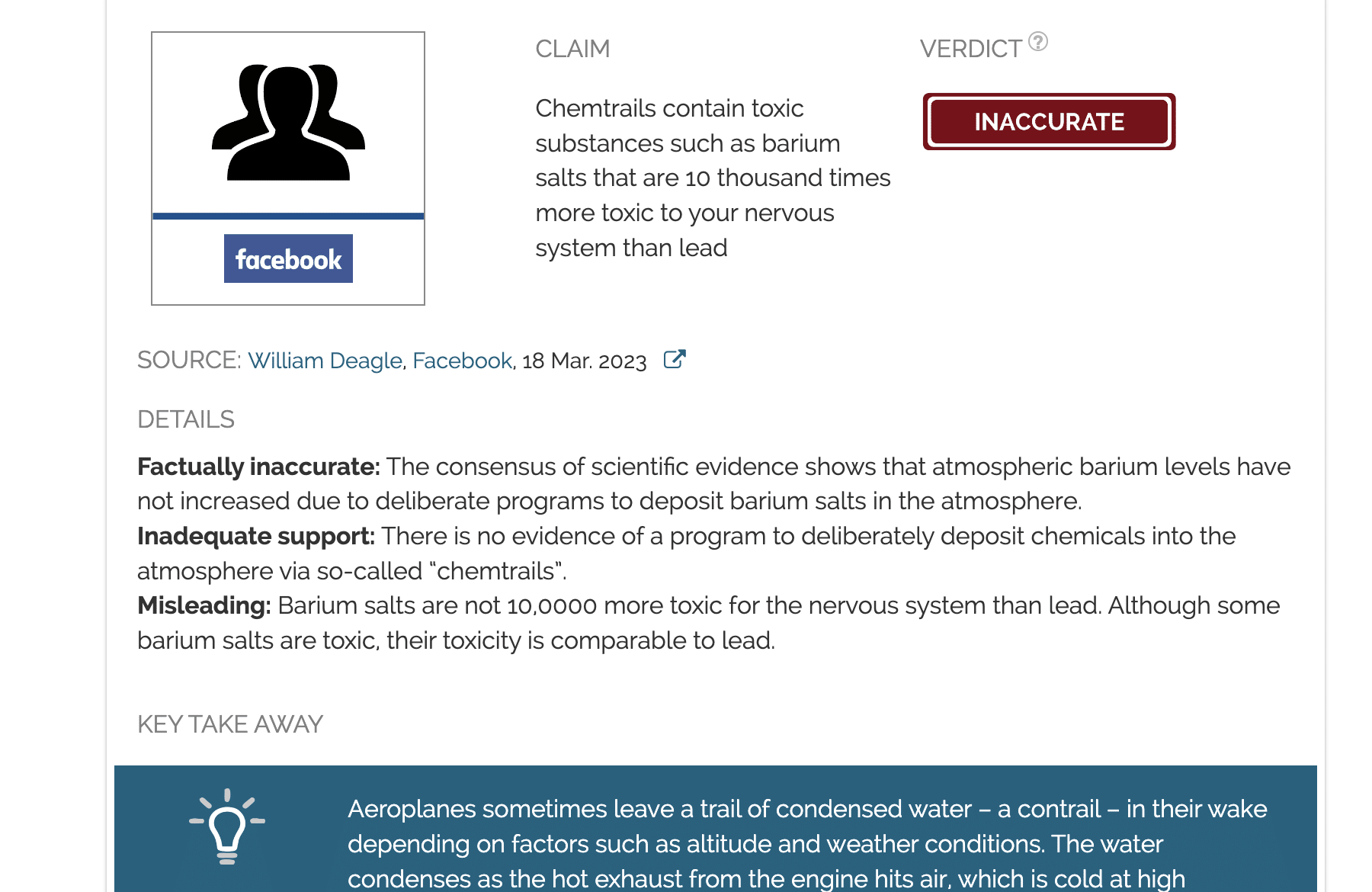- Health
Alleged Morgellons test with cranberry juice doesn’t show nanoparticles, but precipitates from tannin-protein interactions
Key takeaway
The precipitates formed after swishing cranberry juice in one’s mouth are the result of a well-known chemical reaction between plant tannins and proteins in the saliva. Tannins are present in plant-based food and beverages, like tea, berry juices as well as wine, and are what gives these compounds a bitter, astringent taste. Medical consensus currently holds Morgellons disease to be a mental disorder that is very similar to delusional parasitosis, if not the same disease. Further research is needed to understand the cause.
Reviewed content

Verdict:
Claim:
Morgellons test using cranberry juice pulls out nanoparticles from chemtrails and air pollution
Verdict detail
Incorrect: Precipitates formed in berry juices, like cranberry juice, after being swished around in the mouth are the result of a long-recognized chemical reaction between tannins in the juice and proteins in the saliva. The same reaction also occurs with wine, which contains a high level of tannins like cranberry juice.
Full Claim
Morgellons test using cranberry juice pulls out “all these nanoparticles from the chemtrails and from the pollution in the air”
Review
A Facebook reel originating from TikTok, claiming that swishing cranberry juice in your mouth removes “all these nanoparticles from the chemtrails and from the pollution in the air”, went viral in March 2023, accruing more than 14,000 likes and nearly 10,000 shares on Facebook. However, this conspiracy-minded claim is false, as we will explain below.
Cranberry juice contains tannins that interact with salivary proteins
According to the video, clumps or precipitates in the cranberry juice that appear after the juice is spat out is evidence that cranberry juice removes nanoparticles.
However, these clumps are the result of well-known interactions between tannins and salivary proteins. In an email to Health Feedback, Francis Canon, a research director at the Center of Taste and Feeding Behaviour of the French National Institute for Agriculture, Food, and Environment, explained that this process occurs through the binding of tannins to salivary proteins.
Tannins are present in plant-based food and beverages, like tea, berry juices as well as wine, lending these compounds a bitter, astringent taste. Scientific studies dating back to as early as the 1950s showed that tannins interact with various proteins, including those in the saliva, to form precipitates[1-3]. Other videos, like this one, made the same claim using wine in place of cranberry juice. But like cranberry juice, wine contains a high level of tannins and also produces the same reaction.
In short, the clumps of material in the cranberry juice shown in the video are simply the result of tannins in action, but which the video wrongly attributes to nanoparticles. Such interactions “can happen with all juices containing polyphenols, but cranberry juices are especially rich in tannins,” Canon added.
Morgellons is thought to be a mental disorder similar to delusional parasitosis
The term Morgellons is a reference to Morgellons disease, a poorly understood condition that medical practitioners in general consider to be a form of mental disorder known as delusional parasitosis. Those with the condition report having insects, parasites and fibers—often red, blue or white in color—embedded in their skin. Sensations such as itching, burning, and crawling are also common complaints associated with the condition, leading patients to scratch and pick at their skin, resulting in sores.
The term Morgellons disease was first used by Mary Leitao to describe her son’s condition, which doctors had diagnosed as delusional parasitosis and which diagnosis Leitao rejected[3]. The name of the disease originates from a letter dating to the 1600s, written by English physician Sir Thomas Browne, describing a skin disease affecting children in the French region of Languedoc that caused “harsh hairs” to grow on the back.
Leitao created the Morgellons Research Foundation, which successfully campaigned for the U.S. Centers for Disease Control and Prevention to investigate the condition. The study, titled “CDC Study of an Unexplained Dermopathy”, began in 2008 and was performed in collaboration with Kaiser Permanente Northern California and the Armed Forces Institute of Pathology. Study participants were recruited by surveying patients who “reported symptoms that included abnormal skin sensations or sores along with the presence of fibers in the affected skin areas.” A total of 115 participants were included in the study.
The results of the study were published in the peer-reviewed journal PLoS One in 2012[4]. It reported that skin lesions from patients didn’t yield unusual material, and that most material collected from patients’ skin were made of cellulose that likely came from cotton. No parasites were detected.
The study concluded that “No common underlying medical condition or infectious source was identified, similar to more commonly recognized conditions such as delusional infestation”. But it also acknowledged that the condition is “associated with significantly reduced health-related quality of life” and that the majority of patients reported other health problems, including chronic fatigue and cognitive deficits.
For some patients, the CDC study was simply perceived as a government cover-up. It’s common for patients with Morgellons disease to reject the explanation that the disease isn’t due to a genuine infestation. In fact, one of the most common signs of Morgellons disease is the “matchbox sign”, in which the patient presents the specimens of fibers they report having removed from their body in a small container like a matchbox, as evidence of the infestation.
Still, while no organic cause of the disease has been identified, there is no doubt that Morgellons exacts a genuine physical and mental toll on the patient, as news reports show.’The lack of clear answers on what causes Morgellons disease, and some patients’ perception of the mainstream medical establishment as unsympathetic or skeptical of their condition, may explain in part why the disease has attracted multiple conspiracy theories. One example is the chemtrail conspiracy theory cited in the Facebook reel, which is the belief that white trails in the sky are actually from aircraft spraying dangerous chemicals. Motivations given for why chemtrails are deployed range from controlling the weather to mind control to reducing the population.
However, there’s no evidence that this is actually occurring. In fact, the white trails in the sky left behind by aircraft are mainly comprised of water, produced by a reaction between burning jet fuel and air. The water becomes visible because of the low temperatures at high altitudes, just as how car exhaust fumes become visible as white puffy smoke on cold days.
Conclusion
In summary, the precipitates formed after swishing cranberry juice in one’s mouth aren’t the result of nanoparticles from chemtrails and air pollution, as claimed. Rather, they are the result of a well-known chemical reaction between plant tannins and proteins in the saliva. The medical consensus currently holds Morgellons disease to be a mental disorder that is very similar to delusional parasitosis, if not the same. No evidence indicates that it is caused by nanoparticles.
Scientists’ Feedback

Research Director (Center of Taste and Feeding Behaviour), French National Institute for Agriculture, Food, and Environment
Interactions between salivary proteins and tannins lead to the formation of aggregates that precipitate[3]. The process occurs due to the binding of tannins onto salivary proteins. Tannins are multidentate ligands which can bridge proteins, forming aggregates. This process can happen with all juices containing polyphenols, but cranberry juices are especially rich in tannins.
UPDATE (17 March 2023):
Dr. Francis Canon’s comment was added to the review post-publication. This comment further supports the review’s verdict and does not modify it.
REFERENCES
- 1 – Haslam E. (1974) Polyphenol–protein interactions. Biochemical Journal.
- 2 – Ployon et al. (2018) Mechanisms of astringency: Structural alteration of the oral mucosal pellicle by dietary tannins and protective effect of bPRPs. Food Chemistry.
- 3 – Canon et al. (2013) Aggregation of the Salivary Proline-Rich Protein IB5 in the Presence of the Tannin EgCG. Langmuir.
- 4 – Stoimenova et al. (2020) Morgellon disease: A case report. European Psychiatry.
- 5 – Pearson et al. (2012) Clinical, Epidemiologic, Histopathologic and Molecular Features of an Unexplained Dermopathy. PLoS One.



